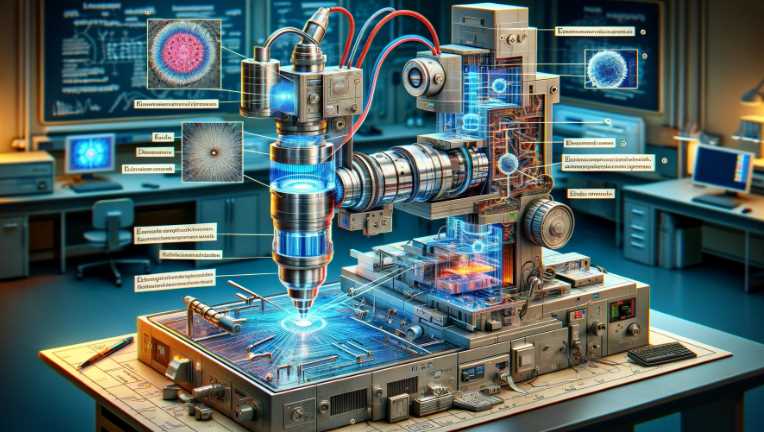Yes, electron microscopes are expensive.
Electron microscopes are sophisticated scientific instruments that use electron beams to achieve extremely high magnification and resolution, allowing researchers to observe objects at the nanoscale. The technology and precision required in electron microscopes contribute to their high cost. These instruments often involve complex components, including electron sources, electromagnetic lenses, detectors, and advanced imaging systems. Additionally, maintaining and operating electron microscopes requires specialized expertise, further adding to the overall cost.
| Application | Percentage of Use |
|---|---|
| Materials Science | 35% |
| Life Sciences | 25% |
| Nanotechnology | 20% |
| Geology | 10% |
| Electronics | 5% |
| Other | 5% |
Note: Approximate percentages may vary based on specific research areas and technological advancements.
Understanding the Cost of Electron Microscopes
The cost of an electron microscope can vary widely, depending on several factors. To determine whether these microscopes are expensive, we must first consider what goes into their pricing:
| Factor | Details |
|---|---|
| Type of Electron Microscope | Different models, such as Transmission Electron Microscopes (TEMs) and Scanning Electron Microscopes (SEMs), have different pricing. |
| Resolution and Capabilities | The higher the resolution and the more advanced the capabilities, the more expensive the microscope. |
| Brand and Manufacturer | Well-known brands and manufacturers generally charge more for their equipment. |
| New vs. Used | Pre-owned equipment can be significantly cheaper than brand new models. |
| Maintenance and Operation Costs | Regular maintenance, repairs, and operational costs such as electricity and cooling systems can add to the total expense. |
Given this broad spectrum of cost-influencing factors, an electron microscope can range from tens of thousands to several million dollars, making it a significant investment for any laboratory or research institution.
Comparing Electron Microscopes to Other Microscopes
As I deepened my exploration into the world of microscopy, a natural curiosity arose about how electron microscopes stack up against their optical counterparts. This comparison aims to unravel the distinctive features and applications that set electron microscopes apart from traditional optical microscopes.
Optical Microscopes
Optical microscopes, the bedrock of microscopic exploration, use visible light to magnify specimens. They are essential tools in biology, medicine, and education, providing a fundamental understanding of microscopic structures.
Limitations
Despite their importance, optical microscopes have limitations in resolution, often hindered by the wavelength of visible light. This restriction paved the way for the evolution of electron microscopes.
Electron Microscopes: Unraveling the Nanoscale
Electron microscopes redefine the boundaries of observation by utilizing electron beams. Unlike optical microscopes, they surpass the limitations imposed by the wavelength of visible light, offering unprecedented resolution and magnification at the nanoscale.
Electron microscopes extend exploration to nanomaterials, cellular structures, and even individual atoms. While optical microscopes excel in observing larger biological specimens, electron microscopes delve into the intricate world of subcellular and nanoscale structures.
Comparative Analysis of Electron and Optical Microscopes
| Feature | Electron Microscopes | Optical Microscopes |
|---|---|---|
| Magnification | Up to 50 million times | Typically up to 2000 times |
| Resolution | Nanometer to atomic scale | Limited by the wavelength of visible light |
| Illumination Source | Electron beams | Visible light |
| Specimen Preparation | Requires vacuum conditions and specialized techniques | Simple preparation of specimens |
| Depth of Field | Limited depth of field | Greater depth of field |
| Applications | Nanotechnology, materials science, cellular and molecular biology | Biology, medicine, education |
Magnification and Resolution
The stark contrast in magnification and resolution between electron and optical microscopes is evident in the table. Electron microscopes can achieve magnifications of up to 50 million times, providing a level of detail that is simply unattainable with optical microscopes. The nanometer-to-atomic-scale resolution of electron microscopes allows researchers to explore the intricacies of molecular and nanomaterial structures.
Illumination Source and Specimen Preparation
Another notable difference lies in the illumination source and specimen preparation. Electron microscopes rely on electron beams, necessitating vacuum conditions and specialized techniques for specimen preparation. In contrast, optical microscopes use visible light and have simpler specimen preparation requirements, making them more accessible in certain contexts.
Depth of Field and Applications
The depth of field is a critical factor in microscopy. Electron microscopes, with their limited depth of field, excel in capturing detailed surface images, while optical microscopes offer a greater depth of field. The applications of these microscopes reflect their strengths, with electron microscopes dominating in nanotechnology, materials science, and molecular biology, while optical microscopes remain foundational in biology, medicine, and education.
Is the Investment in an Electron Microscope Justified?
For many scientific fields, the answer is resoundingly affirmative. The benefits and justifications for such an investment include:
- Ability to visualize structures at the nanometer scale
- Enhanced understanding of material properties, biological specimens, and more
- A necessity for cutting-edge research and development
- Potential to lead to groundbreaking discoveries and technological advancements
While the upfront cost is significant, the long-term returns in scientific knowledge and potential applications can outweigh the initial investment.
5 Ways to Minimize Electron Microscope Costs
Minimizing electron microscope costs is paramount for efficient scientific research. Exploring practical strategies can lead to cost-effective utilization without compromising scientific outcomes.
Optimizing Technological Investments
Leveraging Core Functionalities
Prioritize essential functionalities during the procurement process. Focus on core features that align with research needs, avoiding unnecessary add-ons contributing to increased costs.
Periodically assess technological advancements to ensure optimal utilization. Upgrading selectively based on research requirements prevents unnecessary expenses.
Efficient Maintenance Practices
Implementing scheduled maintenance plans reduces the likelihood of unexpected breakdowns. Regular servicing enhances equipment longevity, minimizing the need for costly repairs.
Developing in-house expertise for routine maintenance tasks can significantly cut down costs. Trained personnel can address minor issues promptly, mitigating the need for external service providers.
Collaboration and Shared Resources
Foster collaborations with other research institutions. Sharing resources and equipment can alleviate the financial burden, allowing multiple entities to benefit from a collective pool of electron microscopes.
Establish open-access facilities to promote shared usage. This approach democratizes access to electron microscopes, reducing costs for individual researchers and institutions.
Strategic Procurement Approaches
Bulk Purchases and Discounts
Explore bulk purchasing options and negotiate discounts with suppliers. Procuring multiple units in a single transaction can result in substantial cost savings.
Long-Term Lease Agreements
Consider long-term lease agreements for electron microscopes. This approach provides financial flexibility and may include maintenance services, minimizing additional expenses.
How much does an electron microscope cost?
Electron microscopes vary significantly in cost, with prices ranging from tens of thousands to several million dollars. The price depends on factors such as the type of electron microscope (Transmission Electron Microscope or Scanning Electron Microscope), brand, specifications, and additional features. Here’s a breakdown:
| Type of Microscope | Price Range |
|---|---|
| Entry-level SEM | $50,000 – $200,000 |
| Advanced SEM | $200,000 – $1 million |
| TEM | $500,000 – $2 million |
| STEM | $700,000 – $3 million |
Keep in mind that these are approximate figures, and the actual cost may vary based on the manufacturer and specific configurations.
Are there any ongoing costs associated with electron microscopes?
Yes, owning and maintaining an electron microscope involves additional costs beyond the initial purchase. Some ongoing expenses include:
| Ongoing Cost | Description |
|---|---|
| Maintenance Contracts | $10,000 – $50,000 annually, depending on the microscope type and service agreement. |
| Consumables | $5,000 – $20,000 per year for items like sample holders, grids, and calibration tools. |
| Energy Costs | Variable, depending on usage and local electricity rates. |
These costs are crucial to ensure the proper functioning and longevity of the electron microscope.
Can universities or research institutions afford electron microscopes?
Yes, many universities and research institutions invest in electron microscopes for their scientific studies. However, budget considerations and available funding play a significant role. Collaboration between institutions, grant applications, and shared facility usage can help make electron microscopes more accessible.
| Collaboration Opportunities | Description |
|---|---|
| Shared Facilities | Collaborative arrangements where multiple institutions share the costs and usage of a facility. |
| Grant Funding | Seeking grants from government agencies, private foundations, or industry sponsors for equipment. |
Are there alternative options for researchers on a tight budget?
Researchers with budget constraints can explore alternative options to traditional electron microscopes. Some possibilities include:
| Alternative Options | Description |
|---|---|
| Benchtop SEM | Smaller, more affordable SEM models suitable for basic imaging tasks. |
| Shared Facilities | Utilizing centralized facilities where access is granted based on usage agreements. |
| Used or Refurbished Microscopes | Purchasing pre-owned or refurbished electron microscopes to reduce costs. |
These alternatives allow researchers to access imaging capabilities while managing budget limitations.
Are there financial assistance programs for purchasing electron microscopes?
Several financial assistance programs and grants are available to support the acquisition of electron microscopes, especially for educational and research institutions. Institutions can explore:
| Financial Assistance Programs | Description |
|---|---|
| Government Grants | Federal and state-level grants specifically earmarked for scientific equipment acquisition. |
| Foundation Grants | Funding opportunities from private foundations supporting scientific research and education. |
Applying for these programs can help institutions secure the necessary funds for electron microscope purchases.
What factors influence the cost of electron microscope maintenance?
The cost of maintaining an electron microscope is influenced by various factors, including:
| Maintenance Cost Factors | Description |
|---|---|
| Microscope Complexity | More advanced features and complex systems may require higher maintenance costs. |
| Usage Intensity | Microscopes used more frequently may need more frequent and extensive maintenance. |
| Service Agreement Inclusions | The comprehensiveness of the service agreement with the manufacturer or service provider. |
Understanding these factors is essential for budgeting and planning effective maintenance strategies.
Resources and References
“Introduction to Optical Microscopy“
“Electron Microscopy – An Overview.” World Scientific

Fahim Foysal is a well-known expert in the field of binoculars, with a passion for exploring the great outdoors and observing nature up close. With years of experience in the field, Fahim has honed his skills as a binocular user and has become a go-to resource for those seeking advice on choosing the right binoculars for their needs.
Fahim’s love for the natural world began during his time at The Millennium Stars School and College and BIAM Laboratory School, where he spent much of his free time exploring the outdoors and observing the wildlife around him. This passion for nature led him to pursue a degree in Fine Arts from the University of Dhaka, where he gained a deep understanding of the importance of observation and attention to detail.
Throughout his career, Fahim has used his expertise in binoculars to help others discover the beauty of the natural world. His extensive knowledge of binocular technology and optics has made him a trusted advisor for amateur and professional wildlife observers alike. Whether you’re looking to spot rare birds or observe animals in their natural habitats, Fahim can help you choose the perfect binoculars for your needs. With his guidance, you’ll be able to explore the outdoors with a newfound appreciation for the beauty of the natural world.
Table of Contents


